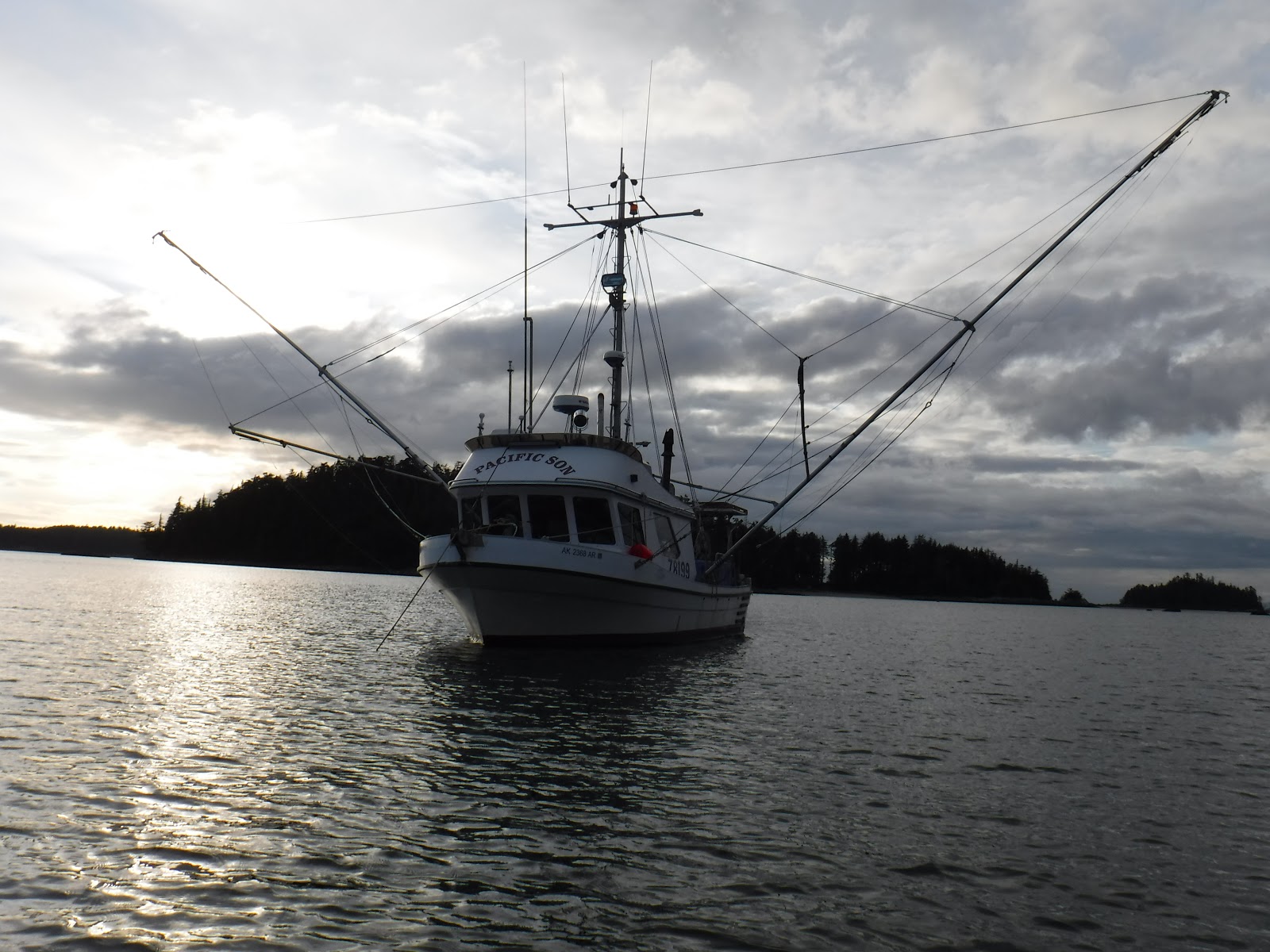Different Kinds of Commercial Salmon Fishing
 |
| Pacific Son is a Troller |
Last Saturday we anchored in Leesoffskaia Bay, which is just
outside of the Deep Inlet fishery. The Deep Inlet area is open to all different
kinds of salmon fishing gear on a rotating basis, which means each kind of
commercial salmon fishery gets its day to fish there. On our way into the bay
there were Gill Netters fishing and on our way out on Sunday it was Purse
Seiners so I got to see both of these fisheries with their gear in the water. Here’s
my layman’s definition of the different kinds of commercial salmon fisheries.
 Troll
Caught Salmon is the only “line
caught” commercial salmon. We use a line and a hook while other commercial
fishing is done with a net. We have a large pole off both sides of the boat
that enable us to have multiple fishing lines in the water at the same time
(the lines are attached to different parts of the poles that keep the lines
separated in the water to avoid tangling them). We are allowed to fish 2 lines
on each side (3 in certain areas). Each line has a lead at the bottom (to weigh
it down) and is marked every 2 fathoms (a fathom is 6 feet). For King salmon
(also called Chinook – prized by fine dining restaurants) we are putting a lure
every 2 marks (every 4 fathoms) but when we start Coho (Silver) fishing in July
we will put a lure on every mark. We are currently running the inside lines
down to 20 fathoms and the outside lines to 16F = 9 hooks on each side of the
boat. We “troll” by dragging these lines through the water at a slow speed
(usually around 2.5 knots). When we get a hit we turn the hydraulics on and
bring each hook up and clear the fish off before resetting the gear and sending
it back down.
Troll
Caught Salmon is the only “line
caught” commercial salmon. We use a line and a hook while other commercial
fishing is done with a net. We have a large pole off both sides of the boat
that enable us to have multiple fishing lines in the water at the same time
(the lines are attached to different parts of the poles that keep the lines
separated in the water to avoid tangling them). We are allowed to fish 2 lines
on each side (3 in certain areas). Each line has a lead at the bottom (to weigh
it down) and is marked every 2 fathoms (a fathom is 6 feet). For King salmon
(also called Chinook – prized by fine dining restaurants) we are putting a lure
every 2 marks (every 4 fathoms) but when we start Coho (Silver) fishing in July
we will put a lure on every mark. We are currently running the inside lines
down to 20 fathoms and the outside lines to 16F = 9 hooks on each side of the
boat. We “troll” by dragging these lines through the water at a slow speed
(usually around 2.5 knots). When we get a hit we turn the hydraulics on and
bring each hook up and clear the fish off before resetting the gear and sending
it back down. 
Gill Netting is when a boat sets a net in the water with floats attached along the top and to each end (or sometimes one end stays on the boat) and lets it “soak” for a time (could be 20 minutes, could be hours). The idea is to capture the school of fish in the net as they swim through so often they will “cork” an opening to a bay or stream by setting the net across the opening. The size of the net opening is determined by the fish you are targeting as you want the little fish to swim through but the bigger fish you are targeting to get their gills stuck in the net. After “soaking” one end of the net is pulled aboard the boat by a hydraulic drum and the fish are hand picked out of the net as it comes up on deck (the net comes aboard only as fast as the crew can pick the fish out). Today, this fishery is mostly used to fish for Chum (also called Dog or Keta) and Sockeye (Red) salmon.

Purse Seining is also net fishing but it is more of a scooping process. A seiner will carry a skiff to the fishing grounds and then the skiff will run the net away from the seiner. The 2 boats will then soak the net between them for about 20 minutes and then the skiff will loop back to the seiner, closing up the net. The bottom of the net is synched up and they will haul the resulting “purse” up with a crane. The net will have scooped up everything that was in the area so once on deck it is dumped out and the fish are separated into keepers and by-catch. Seiners target Pink (also called Humpy) and Chum (Dog) salmon but they capture everything so there is a lot of by-catch (other salmon, other kinds of fish, other sea life like octopus, jelly fish, etc.).



Hey thanks for the lesson, especially which fish each type of boat goes for. And it's great to have a good complete picture of Pacific Son.
ReplyDelete